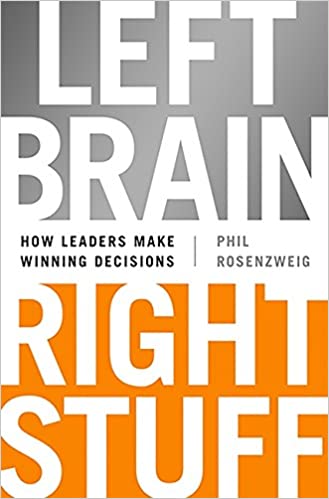Central idea in this book is that winning decisions combine two very different skills which are referred to as the left brain, right stuff.
Left brain is shorthand for a deliberate and analytical approach to problem solving. The right stuff is about the intelligent management of risk. These may seem like opposites, but they’re complementary. For many decisions they’re both essential, left brain logic on it’s own is not enough.
To use the right stuff summon high levels of confidence, even levels that might seem excessive, can be very useful to achieve high performance, particularly if you have any potential control over the outcome. People when asked questions like how long is the Nile and are unsurprisingly frequently wrong, the ranges they provide is far too narrow. This leads to the argument that they are overconfident and need to be cautious to avoid overconfidence in business. However, this is incorrect to apply this observation to business, they are simply applying too much precision. When it comes to managerial decisions, what seems excessive by one definition can be useful, or even necessary by another.
Overconfidence has been used to mean three very different things, which they call overprecision,overestimation, and overplacement (ability to perform better than others). It is often wrong to blame overconfidence as cause of downfall as often factors are outside control of that person, if it went well you would just think they are appropriately confident
Thinking you will putt a golf ball and having that belief increases chances it will happen, positive mindset important in sports.
Illusion of control, is useful to bear in mind particularly if you truly have no minimal control over an activity or outcome. However for many activities we may have some control and the the important lesson is: we should try not to underestimate our control.
Type I error, or a false positive.
Type II error, or a false negative.
Remember to take in base rate of something when thinking about a true positive. Often the emphasis in decision research has been on avoiding Type I errors and not thinking we can do more than we truly can. But if we can take action to influence outcomes, the more serious mistakes may be Type II errors. We should make every effort to influence what we can.
In terms of competitions be sure to know if you are competing for winner takes all or not. As a rule, the greater the skew towards winner takes all the more important it is to outperform rivals and the more extreme chances you’re best to take.
Bias to action at times is a problem, however perhaps the failure to act is a greater sin than taking action and failing, because action brings at least a possibility of success, whereas inaction brings none.
Aim for what the psychologist Martin Seligman calls learned optimism. The key is to replace a static view, which assumes a single mind-set at all times, with a dynamic view, which allows for the ability to shift between mind-sets.
Before an activity, it’s important to be objective about our abilities and about the task at hand. After the activity, whether we have been successful or not, it’s once again important to be objective about our performance and to learn from feedback. Yet in the moment of action, a high degree of optimism even what may seem excessive is essential for high performance.
The aim is to shift from one mind-set to another, gaining the benefits of deliberate thinking, but then shifting completely to implementation.
Authenticity is perhaps over rated as a quality in a successful leader as it is too subjective. In an attempt to be objective you can use predictive models, however be sure not to rely on these if you can influence the outcome.
We must consider not only the dangers of paying too much—a Type I error—but also to the consequences of failing to push aggressively—a Type II error.
The real curse is to apply lessons blindly, without understanding how decisions differ. When we can exert control, when we must outperform rivals, when there are vital strategic considerations, the greater real danger is to fail to make a bold move.
Acquisitions always involve uncertainty, and risks are often considerable. There’s no formula to avoid the chance of losses. Wisdom calls for combining clear and detached thinking, properties of the left brain, with the willingness to take bold action – the hallmark of the right stuff.



